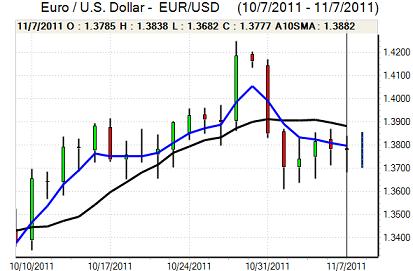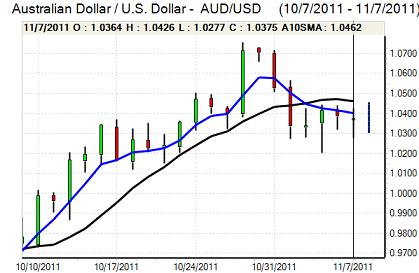EUR/USD
The Euro was again subjected to choppy trading during Monday as it found support below 1.37 against the dollar while there was stiff selling pressure above 1.38. There was further caution over aggressive Euro selling following the strong rally seen in late October and this encouraged positions to be dumped quickly on any sign of a reversal.
The Euro-zone economic data offered no support with the Sentix investor confidence indicator weakening to a two-year low while there was a 0.7% decline in retail sales for October, although the previous data was revised up slightly. There was also a 2.7% slide in German industrial production following the large decline in orders recorded last week.
Political developments tended to dominate during the day as the focus moved firmly to Italy and Italian yields moved even higher into danger territory. There were strong rumours of Prime Minister Berlusconi’s resignation which were later denied as uncertainty continued to escalate. There was little confidence that Berlusconi would be able to survive a budget vote due on Tuesday. Talks also continued surrounding the formation of a new Greek government and the evidence suggested a national unity administration under Papademos remained the most likely outcome.
There were further fears surrounding the financial sector, especially as a loan tranche from the EFSF was poorly-received within the markets. The ECB continued to insist that it would not be a lender of last resort, but did continue buying secondary-market bonds. The weekly total of close to EUR10bn was also significantly larger than expected.
The US trends were of secondary importance during the day, but there was strong demand in the latest Treasury Bill auction as there was further defensive dollar demand. There will be further fears surrounding a cutback in European bank lending which will maintain the possibility of indirect Euro support through repatriation flows, but it would also pose important global risks which would underpin the dollar and the Euro drifted back to the 1.3750 area.

Source: VantagePoint Intermarket Analysis Software
Call now and you will be provided with FREE recent forecasts
that are up to 86% accurate* 800-732-5407
If you would rather have the recent forecasts sent to you, please go here
Yen
The dollar was trapped close to the 78 level against the yen during Monday and drifted slightly lower, but there was little enthusiasm for testing the Bank of Japan’s resolve given the threat of further intervention.
There was still little underlying interest in selling the Japanese currency, especially given the lack of viable alternatives. There were renewed warning from the Swiss National Bank over the franc’s level and this encouraged some flow of funds into Japan as an alternative to the Swiss currency.
There will also be fears over a contraction in European credit flows to Asia which will also trigger some defensive demand for the yen and deadlock with the dollar may persist in the very short term.
Sterling
Sterling again found support on dips to below the 1.60 area against the US dollar on Monday and pushed to highs around 1.6070 before drifting weaker again.
The latest BRC retail sales data recorded a 0.6% decline in the year to October as discretionary spending fell while the RICS house-price index was little changed at -24% from -23% previously.
The data will do little to inspire confidence surrounding the UK outlook and recession fears will be an important focus during the next few weeks.
For now, Sterling is continuing to be driven to a large extent by international trends with further defensive flows into the UK bond market as Euro-zone distress increases. These flows could continue in the near term, although any resolution to the crisis would risk substantial capital outflows.
Swiss franc
The dollar was initially blocked just above 0.90 against the franc on Monday, but it made a fresh challenge higher late in US trading and pushed to highs near 0.9050. There was further notable weakness for the Swiss currency against the Euro as it weakened to test May’s lows near 1.2450.
There were further warnings from National Bank member Jordan that the central bank would act if it saw the need for fresh action.
The latest consumer inflation data was weaker than expected with a 0.1% decline in prices for October with the annual rate also at -0.1%. Although the franc has weakened, the data will increase market unease over deflation and increase Bank determination to prevent further renewed gains.

Source: VantagePoint Intermarket Analysis Software
Call now and you will be provided with FREE recent forecasts
that are up to 86% accurate* 800-732-5407
If you would rather have the recent forecasts sent to you, please go here
Australian dollar
The Australian dollar found support on dips to the 1.0280 area on Monday and rallied to highs around 1.0380, but the currency again found it difficult to sustain the advance.
Domestically, there was a small improvement in the latest NAB business confidence indicator while there was a narrower trade surplus which had a limited market impact.
Trends in risk appetite are likely to remain dominant in the short term and fears that a Euro-zone crisis will trigger a renewed downturn in global demand will tend to undermine Australian currency support.



